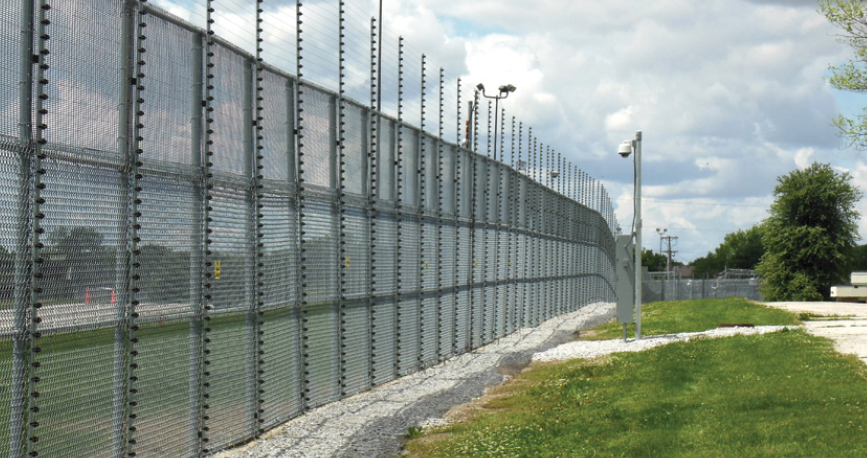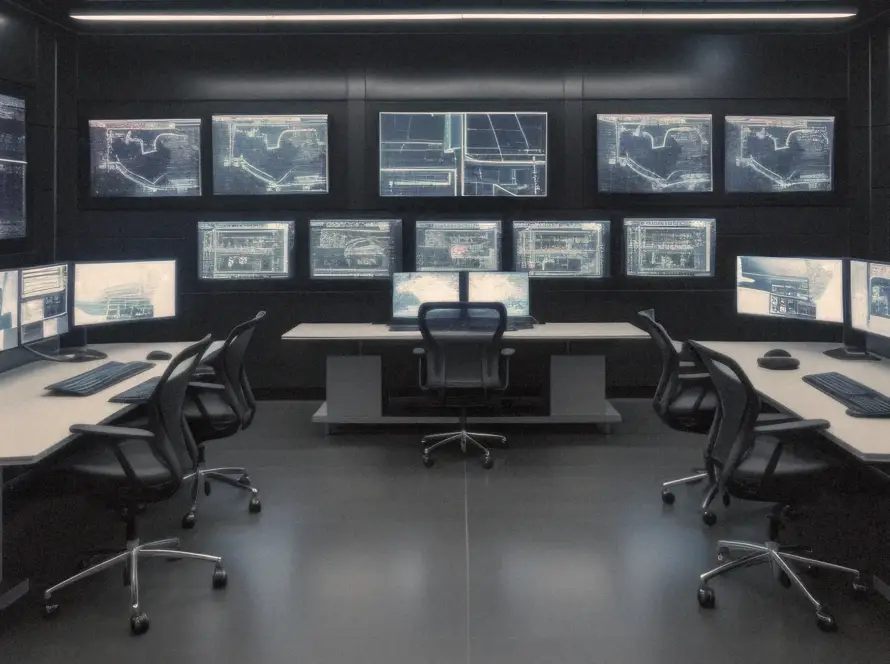Innovation – Challenges
The project we describe involves proactive protection from criminal behaviors (theft and robbery, equipment destruction, vandalism) as well as reactive protection with planned actions and responses to such behaviors. Additionally, it included early warning for potential fire outbreaks (Fire Detection) and access control to the facility (Access Control).
The facility comprises a complex of covered and open storage areas, a depot for parking commercial vehicles, and office buildings for administrative and technical support on the property owned by a public utility organization, responsible for operations across a geographical region of Greece.
The organization’s problem that led to this project involved economic losses amounting to hundreds of thousands of Euros annually from thefts of electrical materials and equipment stored in both covered and outdoor areas of the facility. The largest losses came from the theft of materials containing large quantities of copper, resulting in their vandalism to extract the copper. There were also continuous acts of vandalism on used and retired materials which, though seemingly useless, contained significant amounts of copper as scrap. This material is collected in piles and periodically sent for recycling, creating substantial revenue for the organization. The removal of this material was carried out by regular raids of organized offenders entering through perimeter access points. Due to the size of the facility and the dispersion of the buildings, controlling access to areas beyond visitors’ and employees' jurisdictions was impossible without implementing a technological solution included in the study and execution of the project.
Upon deciding to upgrade the facility's security, it was also agreed to upgrade the fire detection system.
The relevant dimensions of the facility, totaling 181 acres, include a perimeter coverage of 1.9 kilometers and building installations with a total coverage of 27,500 square meters.
The existing security systems were fragmented and outdated, offering a very low level of security in the areas where they were installed. Over the years, standalone installations in various areas and offices, without central code management, with active codes used by employees who no longer worked for the organization, with a single code for everyone, and equipment placed in inappropriate positions due to changes and renovations, essentially lacked any security planning. The outdoor areas were inadequately monitored by a single-digit number of old technology cameras without image recording, and the camera positions did not correspond to sensitive areas that needed monitoring.
The extensive risk assessment study (Risk Assessment) we conducted with on-site research and information from the organization’s staff led us to conclude that, aside from the theft problem, the organization’s activities were extremely sensitive and vulnerable to possible sabotage actions, with very serious consequences that exceeded the organization's operational boundaries if such an incident occurred.
In our final report on the RA results, we suggested classifying the facility as High Risk and drawing up a budget for upgrading the security.
The security solution we proposed, which was ultimately adopted and implemented, was designed based on the principles of what NETIZEN calls Total Security Management.
We understand that security is a concept, not a product. In addition to the technological solution, we designed operational procedures and trained security managers from the existing staff to follow them, ensuring the technological equipment is effective and efficient.
Alongside the installed technical equipment, importance was given to designing and configuring the surrounding area to deter potential offenders from malicious actions. NETIZEN engineers, after attending seminars on Crime Prevention Through Environmental Design (CPTED), incorporated its principles into their solutions. The CPTED principles are based on understanding a potential offender's thought process and creating an environment that discourages violations.
Specific interventions in lighting, configuring paths visitors must follow to the buildings, visible directional signs, prominent security systems, well-maintained building facades, limited and well-kept vegetation, careful placement of large objects to avoid offering cover, all these small interventions collectively signal that the area is monitored and that approaching it involves risk.
The interventions in the surrounding area based on CPTED principles were carried out in collaboration with an external landscaping company.
Special instructions were given to security managers on the importance of CPTED principles and maintaining the implemented interventions.
We designed and implemented a Control Center in a secure location within a building from which the entire facility’s security systems are monitored and managed.
The central units of the alarm and fire detection systems, access control through card readers, and all the cameras installed at critical points were integrated via a closed fiber optic network onto a network platform. The platform's communication with the individual systems is possible using common communication protocols. The management of all systems is now done with a single keyboard and mouse.
Routine commands, such as activating/deactivating alarm system sectors, fire detection system tests, locking/unlocking access doors, etc., are entered into the platform during initial programming and presented to the operator through a series of commands (workflow) that are executed and recorded with or without relevant or necessary comments.
Management of access privileges (who, where, when, how), visitor cards, and door control is done through internal communication and approval.
CCTV camera monitoring is not continuous by the operator as it has been proven that this method is not effective for security. Screens in the Control Center activate cameras needing attention via advanced algorithms and specialized software analysis; however, HD high-definition image recording is continuous, and access to captures/files is easy.
The management/support of foot patrols within and around the facility is also done via the platform and utilizes GPS technology with a special app and smartphone. The workflow confirms that all areas needing inspection are checked. Patrol transition times from one point to another are monitored by software for protection against threat attacks. Emergency situations from the foot patrol are immediately communicated to the operator for appropriate handling.
Management of emergency, threat, alarm, fire situations, what the operator should do during a crisis, is pre-designed and programmed to be displayed in the form of commands needing confirmation. Critical alarms are also sent to the NETIZEN Alarm Receiving Center for further support.
Furthermore, through the platform, operators create and generate reports either for emergency events or for internal use, control, and compliance with the set security policy.
Goals and Design
The solution design we proposed and ultimately adopted and implemented was based on compliance with European standards EN-.
Specifically:
For the alarm system installation, compliance with the standard:
- EN 50131 - Alarm systems - Intrusion and hold-up systems - Grade 3
For the equipment used in the alarm system:
- EN 50131 - Alarm systems - Intrusion and hold-up systems - Grade 4
- EN 50131 - Alarm systems - Intrusion and hold-up systems - Grade 2
- EN 50130 - Alarm systems - Alarm transmission systems
- EN 50136 - Alarm systems - Alarm transmission systems
For the fire detection system (equipment and installation), compliance with the standard:
- EN 54 - Fire detection and fire alarm systems
Note that NETIZEN engineers have received training in the UK and are certified by the official British certification body Fire Industry Association (FIA) for the design, installation, inspection, and maintenance of fire detection systems according to EN 54 standars.
For the CCTV system, compliance with the standard:
- EN 50132 - Alarm systems - CCTV surveillance systems for use in security applications
- BS 8418:2003 - Installation and remote monitoring of detector-activated CCTV systems
The processing of data recorded in the CCTV system and the management of user access data are designed to comply with the EU(General Data Protection Regulations (GDPR))
The selection for the role of the GDPR compliance officer was made by the organization's management, and the training was done in two parts: certified seminars by a specialized body and training by NETIZEN.
NETIZEN has adopted these European standards since 2005, as it has empirically verified the benefits of their application, primarily in reducing false events and the frequency of emergency corrective visits. Our goal is not only to offer quality security to the customer but also to minimize the overall cost of supporting the good operation of the facility during its "lifetime."
We believe that minimizing unnecessary technical visits due to false events should be a key quality objective of a security service provider. Pricing unnecessary technical visits is toxic to the customer-company relationship, emergency mobilization disrupts service planning, the cost burdens both parties equally, and it not only does not produce profit but consumes any initial profit from the project implementation.
Deliverables, Performance, and Achievements
The project was implemented according to the timeline and within the budgeted financial figures and profit margins.
Our communication with the organization’s staff is continuous, and the information we receive indicates that, despite initial difficulties for the staff to adapt to the new, safer conditions and behaviors, the results are positive, and no loss incidents have been recorded. There have been attempts to enter through the perimeter, but they were not completed due to timely intervention via the announcement system (loudspeakers) and the combination of dispatching an immediate response.
NETIZEN's experience in undertaking and completing projects is long-standing and significant, and our goal is always to maintain good relations with our suppliers and customers. These principles lead us to an honest approach, creating goodwill during the formation of this relationship and after its establishment. We avoid promises and never commit to something we cannot deliver. Our expertise covers all areas and fields involved in project implementation, from the moment of ordering equipment from our suppliers in Greece and abroad to signing the delivery certificate. However, when difficulties arise, good relations with our customers, continuous communication, and demonstrating genuine interest work constructively, avoiding unpleasant outcomes.
We consider the implementation of this project one of the great achievements during NETIZEN’s activity. We had the opportunity to utilize state-of-the-art equipment and implement solutions designed for specific and tangible challenges based on our experience and expertise. We believe that our choices over the past years, to invest in continuous education and training and our commitment to compliance with international quality standards, have paid off. We are convinced that this project has allowed us to gain a significant reference project whose added value is clearly greater than the commercial profit derived from its implementation, and we believe it will serve as a useful tool for further developing NETIZEN.
Technology, Management System, and Legal Compliance
NETIZEN has recognized the added value that the assimilation of new technologies in human resource management and the relationship with suppliers and customers brings and uses corresponding technological tools.
The Human Resources (HR) department adopted a unified Human Resources Management System (HRMS) to manage various HR areas such as payroll, time management, recruitment and selection of suitable personnel, employee evaluation, and development through talent management processes. The HRMS has proven to be a particularly powerful tool, allowing for more effective organization and operation of the HR Department and unlocking its potential.
The Customer Relations Management (CRM) suite has been integrated across the company's operational activities. Every customer communication is recorded, as well as the history of the relationship with the company and the services received. Routine and emergency technical visits for preventive and corrective interventions, project management, sales support, sales request tracking, internal meetings, and any potentially useful information are accessible to all NETIZEN staff for retrieval and inputting new data. The CRM also provides the information that forms the quality indicators shaping NETIZEN's strategy and goals.
The financial and sales management departments, through the commercial Enterprise Resources Management (ERP) program with modules supporting all our activities, from material orders, costing, and supply chain to sales, manage NETIZEN's finances more efficiently, significantly reducing the company's operating costs.
Beyond compliance with European security standards for the services provided, NETIZEN strives to offer quality services continuously. For this reason, its staff is trained and encouraged to actively participate in the processes required to ensure the conditions and recommendations described in the management systems for which the company holds compliance certification.
These systems are:
ISO 9001:2015 - Quality Management System
We conduct the required internal audits of quality management systems as per the international standard and provide training to our staff to understand and implement the standard's requirements.
ISO 14001:2015 - Environmental Management System
NETIZEN monitors, measures, and evaluates the type and magnitude of the environmental impacts of its operations.
OHSAS 18001:2007 - Occupational Health & Safety Management System
We ensure that specific procedures exist so that all known potential hazards within our activity scope are continuously recognizable, adequately identified, and located, their contribution to occupational risk is fully assessed, and all risks requiring control are managed with appropriate measures by properly trained individuals.
ISO 27001 : 2013 - Information Security Management System
The security of the information in our systems is of primary importance to us. Organizational risks have been identified, assessed, and managed satisfactorily and correctly. Through NETIZEN's commitment to information security and regular evaluations, we monitor the system's performance and continuously improve it.
NETIZEN complies with all provisions of Law 3707/2008 (Government Gazette 209/A/8-10-2008), which replaced Law 2518/1997, regarding security service companies (I.E.P.Y.A.), and operates according to the operating conditions as well as the required qualifications and obligations of its staff as described in the law.





